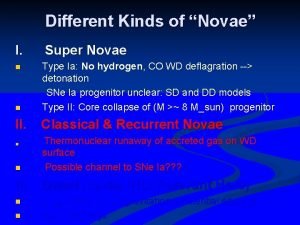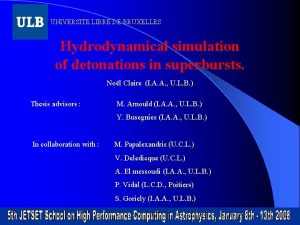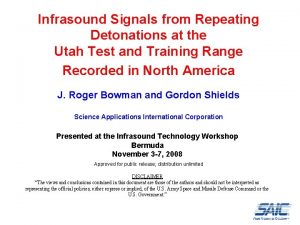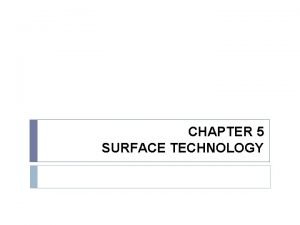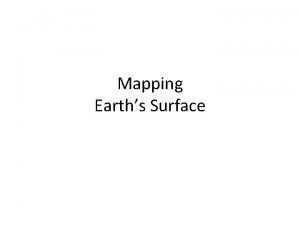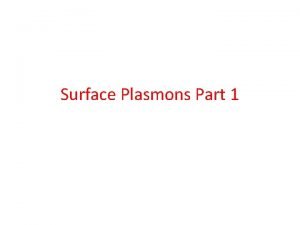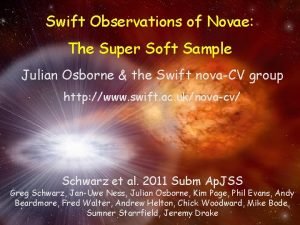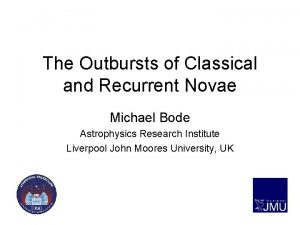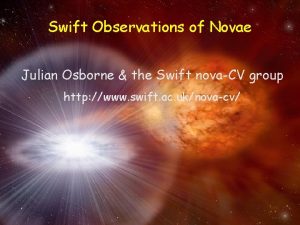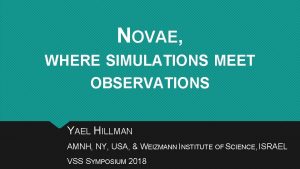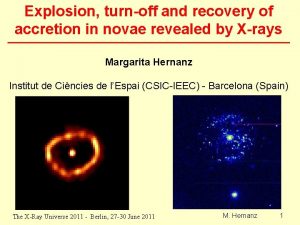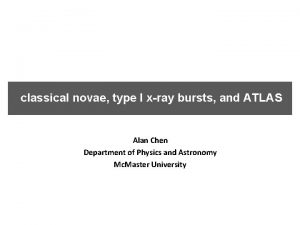Outline Novae detonations on the surface of a









































- Slides: 41

Outline ● Novae (detonations on the surface of a star) ● Supernovae (detonations of a star) ● The Mystery of Gamma Ray Bursts (GRBs) ● Sifting through afterglows for clues


Stellar Explosions Novae White dwarf in close binary system WD's tidal force stretches out companion, until parts of outer envelope spill onto WD. Surface gets hotter and denser. Eventually, a burst of fusion. Binary brightens by 10'000's! Some gas expelled into space. Whole cycle may repeat every few decades => recurrent novae.

Nova V 838 Mon with Hubble, May – Dec 2002 4. 2 pc

Death of a High-Mass Star M > 8 MSun Iron core Iron fusion doesn't produce energy (actually requires energy) => core collapses in < 1 sec. T ~ 1010 K, radiation disrupts nuclei, p + e => n + neutrino Collapses until neutrons come into contact. Rebounds outward, violent shock ejects rest of star => A Core-collapse or Type II Supernova Ejection speeds 1000's to 10, 000's of km/sec! (see DEMO) Remnant is a “neutron star” or “black hole”. Such supernovae occur roughly every 50 years in Milky Way.

Binding Energy per nucleon

Example Supernova: 1998 bw

Cassiopeia A: Supernova Remnant

A Carbon-Detonation or “Type Ia” Supernova Despite novae, mass continues to build up on White Dwarf. If mass grows to 1. 4 MSun (the "Chandrasekhar limit"), gravity overwhelms the Pauli exclusion pressure supporting the WD, so it contracts and heats up. This starts carbon fusion everywhere at once. Tremendous energy makes star explode. No core remnant.

Supernova 1987 A in the Large Magellanic Cloud

SN 1987 A is evolving fast! 1998 1994 Expanding debris from star. Speed almost 3000 km/sec! Light from supernova hitting ring of gas, probably a shell from earlier mass loss event.

A Young Supernova SN 1993 J Rupen et al.

In 1000 years, the exploded debris might look something like this: 2 pc Crab Nebula: debris from a stellar explosion observed in 1054 AD. Or in 10, 000 years: 50 pc Vela Nebula: debris from a stellar explosion in about 9000 BC.

Remember, core collapse (Type II) and carbon-detonation (Type I) supernovae have very different origins

Supernova light curves

Making the Elements Universe initially all H (p’s and e’s). Some He made soon after Big Bang before stars, galaxies formed. All the rest made in stars, and returned to ISM by supernovae. Solar System formed from such "enriched" gas 4. 6 billion years ago. As Milky Way ages, the abundances of elements compared to H in gas and new stars are increasing due to fusion and supernovae. Elements up to iron (56 Fe, 26 p + 30 n in nucleus) produced by steady fusion (less abundant elements we didn’t discuss, like Cl, Na, made in reactions that aren’t important energy makers). Heavier elements (such as lead, gold, copper, silver, etc. ) by "neutron capture" in core, even heavier ones (uranium, plutonium, etc. ) in supernova itself.

Clicker Question: What is the remnant left over from a Type Ia (carbon detonation) supernova? A: a white dwarf + expanding shell B: a neutron star + expanding shell C: a black hole + expanding shell D: no remnant, just the expanding shell

Clicker Question: What is the heaviest element produced by stellar nucleosynthesis in the core of a massive star? A: Hydrogen B: Carbon C: Iron D: Uranium

Clicker Question: All of the following atoms have a total of 4 nucleons (protons or neutrons). Which of the following has the smallest mass? A: 4 hydrogen atoms B: 2 deuterium atoms C: 1 tritium atom and 1 hydrogen atom D: 1 Helium atom E: None of the above, they all have the same total mass

An early gamma ray-burst Vela satellite

A Gamma Ray Burst Sampler

Great debate: 1967 -1997

Bepposax Satellite GRBM: 40 -600 ke. V WFC: 2 -30 ke. V NFI: 2 -10 ke. V

X-Ray Afterglow from GRB 971214 t=6. 5 hrs t=12. 5 hrs t=54 hrs

Optical Afterglow from GRB 971214 Keck Images 2 days 2 months Host HST Image

Optical Afterglow from GRB 080319 b Swift Image Light Curve Naked-eye visible for ~30 sec. Distance = 7. 5 billion ly

Uh-oh

GRB Host Galaxies Bloom et al. 2002

Radio Light Curves from long GRBs

GRB 970508 • First VLBI detection of a GRB Afterglow • absolute position to < 1 mas • Size < 10^19 cm (3 lt years) • Distance > 10000 lt years Taylor et al 1997

GRB Expansion Relativistic Expansion v ~ 0. 96 c E ~ 10^53 ergs (isotropic equivalent) R ~ (E/n)^1/8 Taylor et al 2004 Pihlstrom et al 2007

The Evidence (long GRBs) ● Peak toward low end of gamma-ray, complex gamma-ray light curves ● Often have bright afterglows ● Evidence for a relativistic explosion ● Energy required of ~ 1053 ergs (isotropic) ● Associated with regions of star formation in distant galaxies (out to edge of observable universe) ● Sometimes obscured by dust ● Plus …

Example Supernova: 1998 bw

Long GRBs clearly connected to Supernovae Hjorth et al 2003

Final States of a Star 1. White Dwarf If initial star mass < 8 MSun or so No Event + PN 2. Neutron Star If initial mass > 8 MSun and < 25 MSun Supernova + ejecta 3. Black Hole If initial mass > 25 MSun GRB + Supernova + ejecta

Clicker Question: What is the remnant left over from a GRB? A: a white dwarf + expanding shell B: a neutron star + expanding shell C: a black hole + expanding shell D: no remnant, just the expanding shell

Clicker Question: Where do most GRBs occur: A: in globular clusters B: in star forming regions C: in old open clusters D: in the Oort cloud

Clicker Question: What was the subject of the great debate about GRBs that went on for ~30 years? A: If they were produced by Supernovae or colliding stars. B: If they were galactic or extragalactic in origin. C: If they were of terrestrial or extraterrestrial in origin? D: If a nearby GRB killed off the dinosaurs.


NS-NS binary Coalescence Massive star versus Collapse

 Multi convenerunt studio videndae novae urbis
Multi convenerunt studio videndae novae urbis Quote sandwich format
Quote sandwich format Prism total surface area formula
Prism total surface area formula Spin coat
Spin coat Wet curved surface area
Wet curved surface area Hệ hô hấp
Hệ hô hấp Số nguyên tố là gì
Số nguyên tố là gì đặc điểm cơ thể của người tối cổ
đặc điểm cơ thể của người tối cổ Tỉ lệ cơ thể trẻ em
Tỉ lệ cơ thể trẻ em Fecboak
Fecboak Các châu lục và đại dương trên thế giới
Các châu lục và đại dương trên thế giới ưu thế lai là gì
ưu thế lai là gì Các môn thể thao bắt đầu bằng tiếng bóng
Các môn thể thao bắt đầu bằng tiếng bóng Tư thế ngồi viết
Tư thế ngồi viết Hát kết hợp bộ gõ cơ thể
Hát kết hợp bộ gõ cơ thể Cái miệng nó xinh thế chỉ nói điều hay thôi
Cái miệng nó xinh thế chỉ nói điều hay thôi Mật thư anh em như thể tay chân
Mật thư anh em như thể tay chân Tư thế ngồi viết
Tư thế ngồi viết Ví dụ giọng cùng tên
Ví dụ giọng cùng tên Gấu đi như thế nào
Gấu đi như thế nào Thẻ vin
Thẻ vin Thể thơ truyền thống
Thể thơ truyền thống Khi nào hổ mẹ dạy hổ con săn mồi
Khi nào hổ mẹ dạy hổ con săn mồi Từ ngữ thể hiện lòng nhân hậu
Từ ngữ thể hiện lòng nhân hậu Thế nào là hệ số cao nhất
Thế nào là hệ số cao nhất Diễn thế sinh thái là
Diễn thế sinh thái là Vẽ hình chiếu vuông góc của vật thể sau
Vẽ hình chiếu vuông góc của vật thể sau Lp html
Lp html Phép trừ bù
Phép trừ bù Lời thề hippocrates
Lời thề hippocrates Vẽ hình chiếu đứng bằng cạnh của vật thể
Vẽ hình chiếu đứng bằng cạnh của vật thể Thang điểm glasgow
Thang điểm glasgow đại từ thay thế
đại từ thay thế Quá trình desamine hóa có thể tạo ra
Quá trình desamine hóa có thể tạo ra Công của trọng lực
Công của trọng lực Khi nào hổ mẹ dạy hổ con săn mồi
Khi nào hổ mẹ dạy hổ con săn mồi Thế nào là mạng điện lắp đặt kiểu nổi
Thế nào là mạng điện lắp đặt kiểu nổi Các châu lục và đại dương trên thế giới
Các châu lục và đại dương trên thế giới Dạng đột biến một nhiễm là
Dạng đột biến một nhiễm là Thế nào là sự mỏi cơ
Thế nào là sự mỏi cơ Bổ thể
Bổ thể độ dài liên kết
độ dài liên kết










































